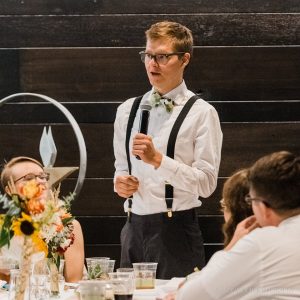22 Practice: Special Occasion Speeches – Giving an Introduction Speech
Special Occasion Speeches: Introductions

This chapter mirrors a D2L LodeStar Activity
Be Prepared to Introduce Yourself
A quick speech can occur on the “spur of the moment.” Will you be ready? Think of the times you are at a birthday party, a funeral, a local town meeting, an awards ceremony or a wedding and someone steps up to say a few words. Are you ready to do so? What if the topic turns toward you — are you able to introduce yourself in a minute or two? Are you ready with an “elevator speech” to introduce yourself to the CEO who just entered the third-floor mailroom elevator with you? It is the hope of your Public Speaking Instructor that you are. This chapter will discuss Speeches of Introduction.
- Read:
- Primary Materials – Chapter 17
- Learning Outcomes Highlighted for this Unit
Students should be able to:
1.1 Demonstrate appropriate topic selection, audience analysis, organization, and content development in a speaker-audience setting.
1.3 Practice effective verbal and nonverbal delivery techniques that are well suited to the occasion and audience.
1.5 Demonstrate the ability to listen, analyze, and provide feedback on public discourse.
What are Introduction Speeches?
When introducing yourself, you might find yourself feeling “exposed” or “vulnerable.” It is a situation that asks you to create a public presentation or “persona” of yourself. Others might also see this as an opportunity to shine! “Networking” sounds a lot better than “exposure!” Like all speeches, an occasion where you must speak about yourself asks you to.
Dr. Scholl (2012) in Chapter 17 speaks to the purpose of the Introduction Speech:
A speech of introduction introduces the main speaker at an event and inspires the audience to listen to that speaker (O’Hair & Stewart, 1999). Any speech of introduction needs to be brief. After all, the person making the introduction should not be the focus of attention. The introductory speech usually has three components: (a) provide a brief backdrop or background of the main speaker, (b) introduce the speaker’s topic, and (c) an invitation from the audience to warmly welcome the speaker (p. 17-2).
Sometimes the Introduction is about YOU!

In this case, given about yourself. Sometimes they are planned and serious, like in a press conference or even in a victim’s impact statement in court. More likely, you will be asked to introduce yourself in a classroom, conference, or work setting. It seems we introduce ourself throughout our lives: show and tell in Kindergarten, the “3 items that introduce me” in a middle school Language Arts class, the first day of a college class.
It is the hope of your Public Speaking Instructor that you will feel confident to rise to the occasion if you are asked to introduce yourself when called upon. Imagine yourself at a conference being asked to, “Introduce yourself, sharing why you are here today, what you hope to gain, and how you will use the materials you learn in the next week.” This is a typical question! Even in classroom settings outside Public Speaking courses, you will experience “Icebreakers” where you share information about yourself. Someone might ask you to share your viewpoint for a news report or on a “Vlog” or social media outlet.
Examples
Example: Carissa’s Self Introduction Speech (https://youtu.be/f9ZZdebK08s)
Example: Jonny’s “Professional Introduction” (https://youtu.be/COLtZGKC4Uc)
Example: Zhade Introduces herself:, (https://youtu.be/fbQ9YJIX6qM):
Example: Joe provides a very different Self Introduction, (https://youtu.be/fN-B0saBa4Q)
Example: Hello! Here is a video introduction assignment (https://youtu.be/ZhtsYrcu1-0)
Adam introduces himself in a casual manner for an opening “discussion” for his Public Speaking Class (https://youtu.be/OqoCErp0IyE):
Example: Tamara’s Introduction Speech (for a discussion board) (https://youtu.be/EmhD0wI6sFA)
Example: Olivia introduces the PSEO program: (https://youtu.be/66jZvX95ano)
https://youtu.be/66jZvX95ano
Example: Kayla introduces the Reunion for an event page: (https://youtu.be/QRlt-lW5040)
Example: Brenden introduces his fraternity (https://youtu.be/sRpihzQYoMc)
Example: Notice how you can give a speech in a location on a topic you are passionate about? (https://youtu.be/5sjdyHWHJRU)
Or take time to say, “Thank you!” – (https://youtu.be/zaCl8eNdTL4)
Here is an example of Jordan’s speech at a conference. (https://www.youtube.com/watch?v=rqP28oACvEk)
He was asked to “say a few words.” Remember, once a video is taken, you might not have control over what happens to it in the “world wide web.” Your comments should be given with caution. Future employers and your grandma might see this.
Will you be Prepared?
Jordan gave the speech above on a “whim” and, he openly shares his opinions. Lucky for him, he is working in sustainable energy today as a professional. Some folks, while younger, post similar messages, videos, comments during conferences, on websites, etc. and sometimes find that this personal opinion might not be as “marketable” or useful in future. Word to the wise – never post a video or comment that you don’t want your grandmother, future employer, potential partner, or even great-grandchildren to see!
This last video (did not link easily as it is in MediaSpace) but it is one of the BEST we have received:
https://mediaspace.minnstate.edu/media/Movie+on+11-5-15+at+3.41+PM.mov/0_w4dagufq

